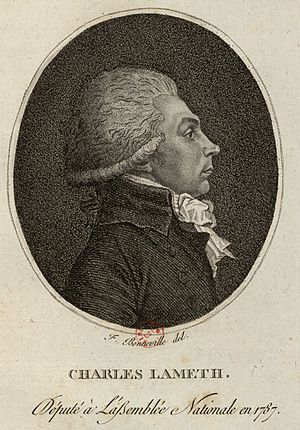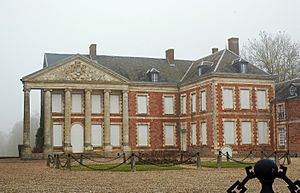Charles Malo François Lameth facts for kids
Quick facts for kids
Charles Malo François Lameth
|
|
|---|---|

Lameth by François Bonneville, 1796
|
|
| Born | 5 October 1757 |
| Died | 28 December 1832 (aged 75) |
| Spouse(s) | Marie Anne Picot |
| Parent(s) | Louis Charles de Lameth Marie Thérèse de Broglie |
| Relatives | Alexandre-Théodore-Victor, comte de Lameth (brother) Théodore de Lameth (brother) |
Charles Malo François Lameth (born October 5, 1757 – died December 28, 1832) was an important French politician and soldier. He lived during a very exciting time in French history, including the French Revolution.
Contents
Early Life and Family
Charles Malo François Lameth was born in Paris, France, on October 5, 1757. His father was Louis Charles de Lameth. His mother was Marie Thérèse de Broglie. She was the sister of a famous general, the Marshall de Broglie. Charles's mother was also a favorite of Marie Antoinette, who was the Queen of France.
A Soldier and Politician
Serving the King
Charles Lameth began his career working for the Count of Artois. This count later became King Charles X. Charles Lameth became an officer in a special cavalry unit called a cuirassier regiment. These soldiers wore breastplates for protection.
Fighting in America
He served in the American War of Independence. This was a big war where the American colonies fought for their freedom from Britain. Charles Lameth was a hero at the Battle of Yorktown in 1781. This battle was a major victory for the Americans and their allies.
Honors and Early Activism
After his military service, Charles received special honors. He became a Knight of the Order of Malta. He also became a Knight of the Order of Saint Louis. These were important awards for his service.
Even though he married a wealthy woman from Saint Domingue (now Haiti), he cared deeply about justice. In 1788, he helped start the Society of the Friends of the Blacks. This group worked to end slavery and fight for the rights of enslaved people.
Role in the French Revolution
Charles Lameth was chosen to be a representative for the nobility in the Estates-General of 1789. This was a big meeting in France to discuss the country's problems. He was one of the first nobles to give up his special rights and privileges. This happened on the night of August 4, 1789, a key moment in the French Revolution.
He continued to serve in the new government bodies, like the National Assembly. In 1791, he even paid back 60,000 francs to the government. This money had been used by King Louis XVI to pay for his and his brothers' education.
Challenges and Exile
In November 1790, Charles Lameth fought a duel with the Duc de Castries. A duel was a formal fight, usually with swords, to settle a disagreement. Lameth was wounded. People worried that the duke's sword might have been poisoned. Charles Lameth was so popular that a crowd of people attacked Castries' house in revenge.
As the Revolution continued, different political groups formed. Lameth believed in a constitutional monarchy. This meant he wanted France to have a king, but with limited power, controlled by a constitution. He was part of a group called the Feuillants.
However, the Revolution became more extreme. On August 12, 1792, Charles Lameth was arrested in Rouen. He had protested against the attack on the Tuileries Palace. This was an attack on the king's home. As France moved towards becoming a Republic (a country without a king), Lameth left France. He went to live in Hamburg.
Return to France and Later Career
Charles Lameth returned to France when Napoleon Bonaparte came to power during the Consulate period. In 1809, he was made a Brigadier General. He fought in the Spanish War. He was also appointed governor of Würzburg during Napoleon's First Empire.
By 1814, he had become a Lieutenant General. After Napoleon's defeat, the old royal family, the Bourbons, returned to power. Charles Lameth supported them, just like his brother Alexandre Lameth. In 1829, he took over Alexandre's role as a deputy, serving as a representative in the government. In his final years, he also supported the July Monarchy, which was another new monarchy in France.
Personal Life
Charles Lameth married Marie Anne Picot. They had two children together. Their family home was the Château d'Hénencourt in Hénencourt, which is in the Somme region of France.
Charles Malo François Lameth passed away on December 28, 1832.
Images for kids




